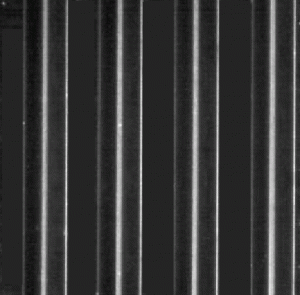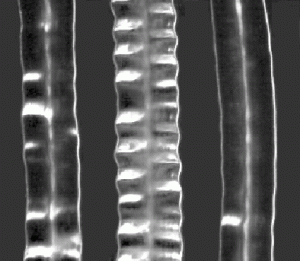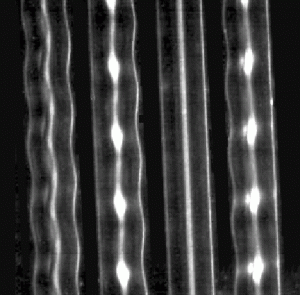- Published Aug 6, 2013 in Gear Garage
Scott Hull takes a microscopic look at the physical properties of vinyl records and the grooves that produce sound.
For most of my clients and friends, there is nothing quite as cool as looking at the grooves that make a record. To be able to “See” the music, the relationships between high frequencies and lows is just mesmerizing. It looks so simple, yet seems so complex. I know it’s just a waveform display turned sideways, but the fact that it’s tangible and not in a computer helps us connect with the music.
As disk cutting engineers we are always looking at sound. We have a microscope mounted on the record cutting lathe and we use this scope to determine the quality of the cut and to diagnose problems when they occur. We can also measure the groove width and separation between the grooves. The space between the grooves is called “land.”
So, What do the squiggles mean? Lets look at the record groove closely. Very closely
In the microscope a simple quiet groove looks like Fig.1.

Fig 1. A simple quiet groove.

Fig 2. Music grooves in a vinyl record
There are four grooves in this picture. Each groove looks like three “lines.” The light from the scope lights up the bottom of the groove and the top edges. This is a picture of grooves cut in a fresh lacquer. It’s a very clean and quiet cut. This groove would make a very good sounding – albeit silent record.
When we add music to the picture this is what can happen to our cute little grooves. (Fig.2) We can notice the grooves move back and forth and they get fatter and skinnier.
Other things we can notice are that there are large sways in the groove that look a little like sine wave. These are the bass frequencies. Bass frequencies have large wavelengths and when cut they make the groove move in long sweeping curves. They’re so long I can barely get part of a wavelength in one slide.
We can also see grooves that have tight little squiggles that look something like fish scales (center). These are the higher frequencies. Instruments like a cymbal or trumpet can make the very tight squiggles like those in the middle groove.
These sharp, high frequency squiggles are something we’re constantly dealing with. The sustained bright “S” sound is a particular challenge. In fact, there are so many reasons why “esses” are problematic I’ll devote a whole blog entry to just that.
The goal is to cut a “bright” groove that can still be played back by a standard quality needle and cartridge. If the movements of the groove are too sharp and bright, not all playback cartridges will be able to track the groove accurately. When a needle fails to track the groove you hear a fuzzy sounding distortion. A stiff DJ cartridge–one that is durable and can stand up to scratching and back cue-ing–will often be too stiff to accurately track all those sharp turns. “Hi-fi” cartridges are designed to have the flexibility to track those turns accurately. The trade-off is that they tend to be very delicate, and expensive.
In Fig.3 we have cut some sine wave tones so that we can see more clearly the independent movement of the left and right channels.

Fig 3. Sine wave grooves in a vinyl record
This is a really interesting slide. It wasn’t easy to get all four grooves in one picture–and it wasn’t edited together in Photoshop, either!
The groove on the left is a recording of a 4,000 cycle tone (4kHz) in both left and right channels in phase. Since the signal was in phase, the depth of the groove is constant, and you simply see the sine wave wiggles of the left and right walls. The left wall is the left channel; the right wall the right channel.
In the second groove you can notice that the left wall is straight. The left channel is silent and the right channel is playing the test tone on it’s own. Since the two channels are not identical in this example, the groove gets alternately deeper and shallower. This is because the channels are not in phase and it causes the playback needle to rise and fall. Remember that even though there are two channels of audio, there is only one point where the stylus touches the record. The movement of the groove, left and right, up and down, is completely analogous to the movement of the left and right speakers upon playback.
In the third groove both channels are off. This is our silent groove like the first photo above. And then the last groove has audio on the left channel and the right channel is silent. I love this slide–because it clearly displays what motion is shared by both channels and what is independent motion.
One of my favorite things is sharing my passion for music. And there are few music fans as passionate about their music as vinyl lovers. If you have not given a commercial vinyl release serious thought, you should. Not only is vinyl “buzzy, hip and awesome” it completes the music listening experience for many of us. The large format artwork and the playback process are just some of the factors that make people stop for a moment and listen to the music.

